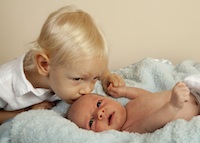By: Stephanie Duhon
Having or taking care of a child means you are responsible for that child’s welfare. Do you know what to do if the child starts choking or stops breathing? According to the National Safety Council, choking and suffocation is the third leading cause of unintentional injury death for infants under age 1. Babies put anything in their mouths. It’s part of how they learn the world around them. Keeping small objects out of baby’s reach is the best way to prevent an injury, but it’s still crucial to know what to do in an emergency situation just in case. A CPR class can teach you life-saving techniques.
The Motherhood Center offers the American Heart Association’s Family and Friends CPR course. The class teaches techniques such as the Heimlich maneuver, chest compressions and basic first aid. While there are many websites that cover basic CPR, this class gives you actual hands-on training and a chance to ask questions. Each attendee practices with an infant-sized doll to better understand how to properly do each maneuver. The instructor goes over the differences between treating an infant, a child or an adult. The basics of using an Automatic External Defibrillator (AED) are also covered. This knowledge is especially useful for people who work on a campus or in an office building with access to an AED.
In addition to parents, we recommend that anyone caring for your baby, such as grandparents or babysitters, should take a CPR class. Infant, Child and Adult CPR is offered twice a month on Mondays and Saturdays. You can find our more or register here.
Sources:
https://www.nsc.org/safety_home/HomeandRecreationalSafety/Pages/Choking.aspx



